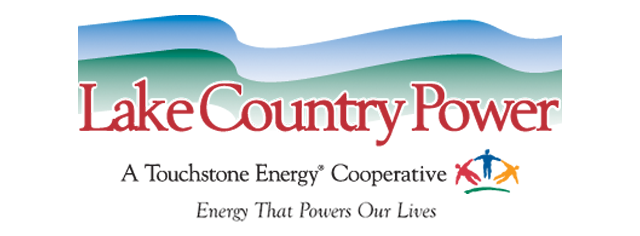Below are common questions asked about Lake Country Power:
Electricity remains a great value. Electric rates for the typical member have risen on average one and half percent (1.5%) per year over the last 28 years. Our challenge locally is to keep rates affordable, electric service reliable, and the co-op in a solid financial position (while power costs continue to rise) so we can continue to provide you with the electricity to turn on your lights, heat your home, keep your coffee hot, and charge your batteries while still meeting financial requirements set by lenders.
Prior to signing its most recent power purchase contract with Great River Energy, Lake Country Power received ten proposals from seven different suppliers, including Minnesota Power. The “reward” was a projected first year savings of $0.15 (fifteen cents) per month to a typical residential member. The projected savings declined to almost zero by the end of the contract period.
Lake Country Power’s rates are very competitive with other electric cooperatives in northern Minnesota. One significant difference between Lake Country Power and investor-owned utilities (like Minnesota Power), or city-owned utilities, is that the other utilities average between 35 and 55 customers per mile of line. Lake Country Power averages six members per mile. The costs for line construction and system maintenance are the same, but we have fewer consumers per mile to pay for the line, customer service support, materials and equipment.
Electric co-ops were formed years ago because there wasn’t enough "profit" for investor-owned utilities to serve rural areas with electricity. That’s why co-ops were formed … and that’s why we’re still here today. Our job is to provide safe, reliable and affordable service on an at-cost basis in areas that don’t provide the return that other utilities, like investor-owned energy providers, prefer.
Co-ops, like Lake Country Power, are cost-based electric utilities and our charges to you are only for the costs of providing the electric service to your home, cabin or business. After expenses for providing your electricity are paid, the money left over (the margin) is set aside for all members who purchased electricity during the year in a Capital Credit account.
The monthly fee recovers a portion of the local co-op cost of delivering electric energy to members. Part of our “fixed” costs are also collected through the kilowatt-hour charge.
- It accounts for the co-op’s investment in equipment like poles, wires and transformers, as well as labor to provide members with safe and reliable electric service.
- It supports fleet, facility and customer service functions, such as line maintenance, right-of-way clearing, member service support and administrative responsibilities.
- It’s similar to monthly fees that other utilities charge (such as telephone service providers, cable companies, satellite TV services, or mobile phone charges).
If one member uses only one kilowatt-hour of electricity and another member uses 1,000 kWh, the cooperative still incurs the same cost to build the line, maintain the distribution system and deliver electricity to both customers. The co-op’s rates are set to recover costs as fairly as possible so you have lights, heat or other comforts provided by electricity when you need it, regardless of how much energy is used by individual members.
- If you're comparing apples to apples, Lake Country Power’s rates are comparable to other rural cooperatives in northern Minnesota.
- Some utilities have higher monthly fixed service availability charges, while others blend a lower facilities or service charge with a higher energy (kWh) charge. Most utilities also include a power cost or resource adjustment.
- If we had higher density (more members on our system) it would help lower the overall fixed costs (the service availability charge) for each consumer on the system.
- Lake Country Power averages six members per mile of line. We maintain more than 8,100 miles of line.
- Utilities that serve cities, towns and higher density areas typically average between 35 and 55 consumers per mile. The higher density helps offset the monthly costs for equipment like poles, wires, transformers and maintenance as well as service to consumers on a utility system. A rural system like ours that averages six members per mile of line doesn’t have the same consumer density as a city, suburb or town to help spread costs across the system.
- The costs for line construction and system maintenance are the same, but we have fewer consumers per mile to pay for the line on a rural system.
Lake Country Power offers a number of options to help you manage your power bill.
- rebates for energy efficient appliances
- budget billing, which evens out your payments year-round and provides a way to manage your monthly bill and your monthly budget
- home energy assessments and audits
- low-cost Energy Wise heating and cooling programs (even with a slight increase projected in 2012, we expect electric rates for load control programs will remain very competitive in comparison to other fuels)
- automatic payment options – with LCP Easy Pay, an automatic monthly bank drafting option
If you are interested in learning more about these services, contact us at 800-421-9959.
- Set your thermostat to the lowest comfortable temperature setting in the winter
(Dept of Energy recommends 68 degrees) - Insulate your water heater
- Caulk around doors and windows
- Repair leaking hot water faucets
- Turn off lights when you leave a room
- Wash and dry full loads of laundry (or air-dry loads, but don’t overload the dryer)
- Lower the thermostat on your water heater to 120 degrees F
- Replace or clean your air filters once a month
- Invest in energy-efficient equipment. When upgrading look for the ENERGY STAR® symbol
- Check out our residential in-home energy assessments and other practical energy-saving ideas online.





